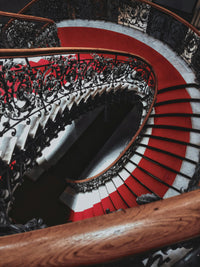Most of you have probably come across covered steps and never thought much about them. Well, this article is all about those covers - non-slip treads - and why they matter.
They help prevent slips and falls, making stairs safer for everyone. They add extra grip, so you’re not sliding around, whether indoors or outdoors. And the best part? They’re an easy and affordable way to upgrade your stairs without a big renovation.
If you want safer, sturdier steps without much hassle, keep reading. We’ll break down the best non-slip treads and how to pick the right ones for your space.
Types of Non-Slip Stair Treads
1. Carpet Stair Treads
-
Adhesive Non-Slip Treads: These are the peel-and-stick kind—just stick them directly onto your stairs and you're good to go. No tools, no extra work. They stay in place, giving you solid grip without shifting around. Perfect if you want a quick, no-fuss solution that won’t budge.
-
Non-Adhesive Non-Slip Treads: These don’t have sticky backs, so you secure them with tacks, tape, or even a rug pad. The upside? You can move or replace them easily without leaving any residue behind. A great choice if you like to switch things up or live in a rental where you can’t use permanent fixes.
-
Custom Non-Slip Treads: Got oddly shaped stairs or a unique design? Custom treads are made to fit exactly how you need them. Whether your stairs are extra wide, curved, or have a specific look you want to match, you can get treads tailored just for your space.
2. GRP (Fiberglass) Stair Treads
-
Standard Duty: These are perfect for homes and light-use areas like indoor staircases, basements, or small offices. They add grip without being too rough, making them comfortable to walk on, even barefoot. If you just need a little extra safety for everyday use, these get the job done.
-
Heavy Duty: Built for high-traffic areas and outdoor steps that see a lot of action. Whether it’s a busy workplace, a public space, or just stairs that get hit with a lot of rain and dirt, these treads can handle the wear and tear. They’re tougher, last longer, and stay put even with constant foot traffic.
-
Fine Grit: These are designed for wet, slippery surfaces where regular treads might not cut it. Think pools, boats, or outdoor steps that get slick when it rains. The extra-fine grit gives you grip without feeling too rough underfoot, making them a smart choice for safety in slippery spots.
3. Rubber & Vinyl Stair Treads
-
Rubber Non-Slip Treads: If you want something soft, durable, and easy on the feet, rubber treads are a solid choice. They cushion your steps, making them great for homes, kids, or anyone who prefers a little extra comfort. Plus, they’re tough enough to last, especially for indoor stairs that get regular use.
-
Vinyl Non-Slip Treads: Vinyl treads are the budget-friendly, no-fuss option. They resist wear and tear, so they’ll hold up over time without breaking the bank. If you need something simple, durable, and easy to clean, vinyl gets the job done without costing a fortune.
4. Metal Stair Treads
-
Aluminum or Steel: If you need something tough and built to last, metal treads are the way to go. Aluminum is lightweight and rust-resistant, while steel is extra strong for heavy-duty use. These are perfect for industrial settings, outdoor staircases, or anywhere that takes a beating from weather and foot traffic. They won’t wear down easily and can handle just about anything.
-
With Grit Strips: These come with built-in grip strips that add extra traction where you need it most. Whether it’s a busy workplace, outdoor steps, or stairs that tend to get slippery, grit strips help keep things safe without covering the entire step. A great choice for those who want safety without changing the look of their stairs too much.
How to Choose the Right Stair Treads
Now that we’ve covered the most popular and widely used types of non-slip treads, let’s talk about how to choose the right one for your stairs. Not all treads work the same for every space, so there are a few key things to keep in mind before making a decision.

-
Material
-
Wood Stairs: If you have hardwood steps, carpet treads (adhesive or non-adhesive) are a great option to add grip without damaging the wood. If you prefer something lower maintenance, rubber or vinyl treads work well since they stay put without requiring nails or screws.
-
Metal Stairs: Metal steps (like steel or aluminum) can get slippery, especially outdoors. GRP (fiberglass) treads or grit-strip treads are ideal because they provide strong grip and can handle weather, moisture, and heavy use. If you want something simple, rubber treads with adhesive backing can also work for indoor metal stairs.
-
Concrete Stairs: Concrete is durable but can be hard and rough underfoot. For outdoor concrete stairs, heavy-duty GRP treads are the best bet since they can handle rain, snow, and dirt. For indoor concrete stairs, rubber or vinyl treads add grip while making steps a little more comfortable to walk on.

-
Size & Fit
When choosing non-slip treads, you want them to fully cover the step without hanging over the edge. Overhanging treads can become a tripping hazard instead of preventing slips. If the edge curls up or isn’t securely in place, it can catch your foot and cause more problems than it solves.
-
Usage
Where you’re placing your non-slip treads matters - a lot. For indoor stairs, most treads will work fine, and it’s more about personal preference and comfort. But for outdoor steps, you need to be extra careful. The wrong treads can fade, wear out fast, or even become more slippery when wet. Commercial spaces also have different needs since they get way more foot traffic than home stairs. Choosing the right treads for the right setting isn’t just about durability - it’s about safety and long-term performance. So before buying, make sure the treads you pick are actually designed for where you’re putting them.
-
Installation
The last factor to determine your choice is installation - do you want something temporary or a more permanent fix? Different types of treads come with different levels of installation, so it’s important to choose one that fits your needs.
If you’re a renter or just want an easy-to-remove option, go for non-adhesive carpet treads or rubber treads with grip backing. These stay in place without damaging the stairs and can be removed without leaving a trace.
For a more secure, long-term solution, adhesive treads stick directly onto the surface, while GRP and metal treads require screws or bolts for heavy-duty hold. These are ideal for areas where you don’t want to worry about maintenance or replacing them often.
The good news? Installing treads doesn’t require a professional hand - it’s simple enough to do yourself. But in the end, it’s all up to you and what works best for your space.
Conclusion
I hope I covered everything there is to know about non-slip treads - everything and more to help you make a decision. Whether you’ve never thought about adding covers to your stairs or you’re looking to switch to something safer, now’s your chance. A simple upgrade can make a big difference in preventing slips and keeping your stairs safe for everyone. If you need help choosing the right solution or want to explore high-quality safety upgrades, check out our handrail collection or get in touch with our team - we’re happy to help.









